Continuing to familiarize myself with the history of ancient Egypt, I want to introduce you, dear friends, to another Deity worshiped by the inhabitants of the country of the pharaohs. Hathor - the patroness of women, was a particularly revered goddess in the Egyptian pantheon, her essence embodied the principles of joy, female love and motherhood, and the main cult center of this magnificent Goddess was in the ancient city of Dendery.
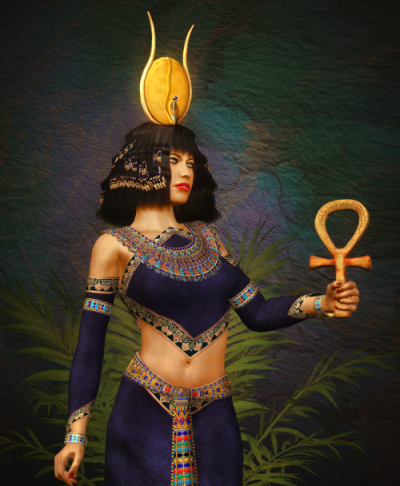
The goddess Hathor. Contemporary artist's view
Today the temple of the Goddess Hathor is one of the most beautiful sanctuaries among all, preserved ancient cult centers in Egypt. This magnificent complex is struck by a unique decor, elaborately carved figures, an amazing picture of carefully written hieroglyphs of texts and wonderfully painted ceilings.
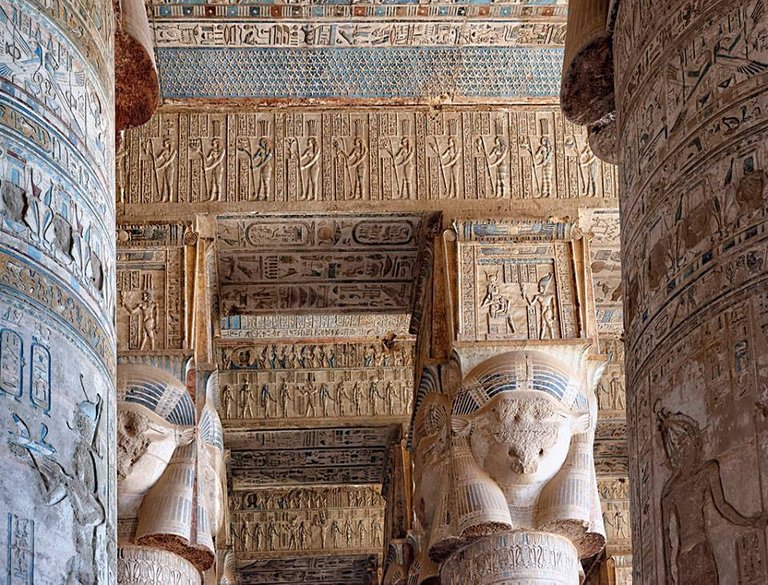
Geographical information
Dendera is located on the west bank of the Nile, about 60 km north of Luxor, in the 6th Nome of Upper Egypt. The complex of the temple of Dendera is 2.5 km to the south-east of the city itself.
Hathor, the turquoise goddess of the Nile Valley
Shadow Hathor is present in many places connected with the monumental history of Ancient Egypt. She was one of the most important goddesses of the Nile Valley and remains one of the most famous symbols of the ancient Egyptian religion.
Hathor was the goddess of joy, of female love and motherhood. In ancient Egypt, she was worshiped by both royal people and ordinary people. It was believed that she helped women in childbirth, and also patronized musicians and dancers. To the Goddess Hathor were treated with entreaties dreaming of becoming the mother of a girl.
The goddess was known as the Mistress of the West, Turquoise and Foreign Lands. The very first mention of it originates from the Fourth Dynasty (approximately 2613 -2494 BC), but there is also information that its cult is probably much older.
Queen Hatshepsut, the first woman Pharaoh, added a small shrine dedicated to Hathor in the funeral temple in Deir el-Bahri. For the powerful ruler of ancient Egypt, Hathor and Sekhmet (Goddess with a lion's head) possessed all the attributes that a woman can beg for herself.
However, the male rulers of Egypt also worshiped the Goddess Hathor. For example, Ramses II built two temples in Abu Simbel - for the Goddess Hathor and his beloved wife Nefertari.

Cult of the Goddess-Cow
Hathor was portrayed as a woman with a cow's head, a cow's ears or just like a cow. The cow on the palette of Narmer, in all probability points to it. The artifact dates back to the pre-dynastic era and can be the earliest depiction of Hathor.
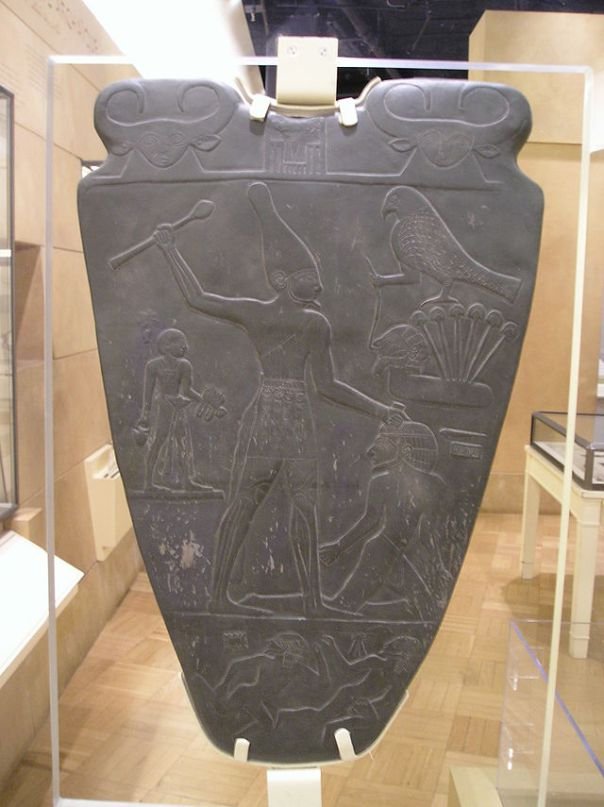
The palette of Narmer with a symbolic image of cow's heads at the top
Some of the most valuable statues of Hathor belong to the period of the reign of Amenhotep II (circa 1427-1400 BC). He portrayed himself standing in front of Hathor (in the form of a cow), calling for her protection. Although Hathor was sometimes represented as a woman with a cow's head, but more often she was portrayed as a beautiful, slender woman, wearing a headdress with a pair of cow horns and a sun disc between them.

In the Book of the Dead Hathor is depicted as a cow that greets the deceased in the afterlife. Her symbol was "sistrum" - a musical instrument that made a sound like a tambourine. In mythology, the Goddess possessed healing abilities. For example, in one of the myths, she healed the eyes of Horus, after Seth (well, the one who killed the father of Horus - Osiris) punctured them.
According to this legend, Hathor, who had caught Horus crying in the desert, suggested that he catch a gazelle and give it to her. (A wonderful way for a blind person to catch a gazelle ?!) After that, she dipped milk into Khoras's eyes, thereby restoring his sight.
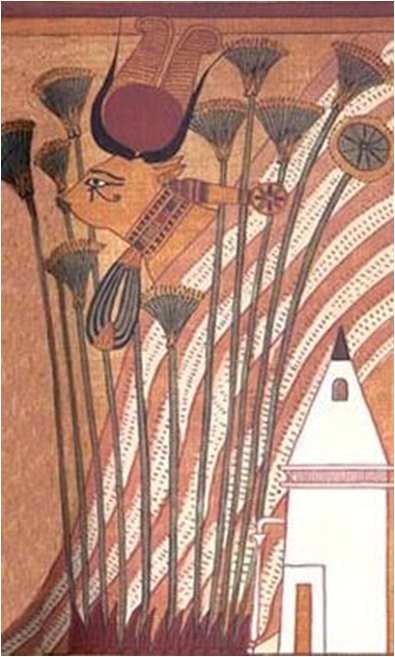
Hathor, depicted with the eye of Horus - Papyrus Ani ("The Book of the Dead")
Temple of the Goddess Hathor in Dendera
It is believed that Dendera is one of the oldest holy places, even by the standards of the ancient Egyptians. Some texts indicate evidence of the existence of religious structures built on this site during the reign of Pharaoh Pepi I (end of the third millennium BC). There are also ruins of the temple, which was built during the New Kingdom, in particular the 18th dynasty (the end of the second millennium BC). The current complex, including the Temple of Hathor, dates back to the Ptolemaic periods and Roman rule (3rd century AD), but here, there is a beautifully preserved building dating back to the earlier period - the house of the Mammisi (house of birth) Nectanebo II, the last of the Egyptians - the ruler of the ancient country of the pharaohs, who ruled in the IV century BC.

The temple complex in Dendera covers an area of 40,000 square meters and is surrounded by a large wall. Inside this complex are various buildings, including the Birth Temple of the Goddess Isis (the one that her husband Osiris collected in parts, remember?), The Roman "mammisi" (attributed to the kingdom of Troyan or Nero), a healing temple and a sacred lake.
The complex in Dendera is known all over the world as a rock carvings, which many consider an electric light bulb.
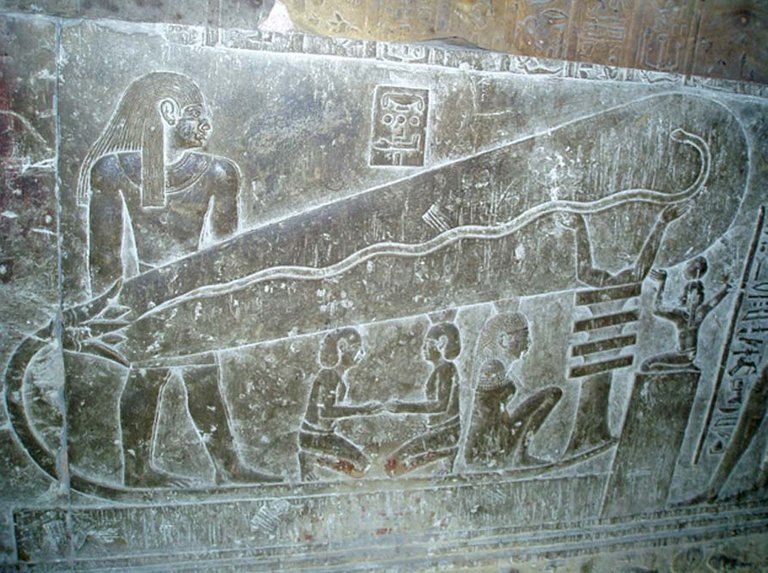
Nevertheless, the most impressive part of the temple complex is, undoubtedly, the Hathor Temple.
The temple of Hathor was built on the site of ancient religious buildings in Dendera during the reign of Ptolemy XII and Cleopatra VII. Later additions to the sanctuary of the Dendery complex were made during the Roman period. But despite the fact that the rulers of the late 4th and early 5th century AD were not themselves Egyptians, the design of this temple is consistent with other classical Egyptian temples. The exception is only the front part of the hypostyle (without the roof) hall, which, according to the inscription above the entrance, was built by the Emperor Tiberius (14-37 AD).
Worshiping the Egyptian gods
Like the ancient pharaohs, their successors - the Ptolemies and later Roman rulers of Egypt - also used the temple complex as a means of propaganda and demonstrating their piety to the Egyptian gods. Thus, for example, in the hypostyle hall of the temple of Hathor, the Roman emperor Nero is depicted, offering the model of the "mother" to the goddess. This image was cited as evidence that Nero took part in the construction of the Roman birth house. On the other hand, initiations and ornaments in the Mammisi itself refer to Troyan, suggesting that this emperor was responsible for the erection of the birthplace.
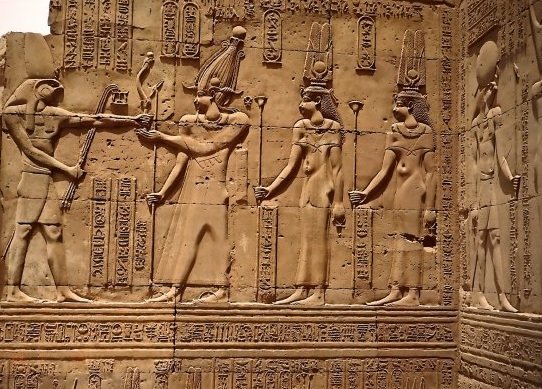
Images in the Temple of Hathor
In addition to these images, in the temple complex there are also scenes depicting the rulers of the Ptolemaic dynasty. For example, carved on the outside of one of the walls of the temple fresco shows Cleopatra VII and her son Ptolemy XV, better known as Caesarion.
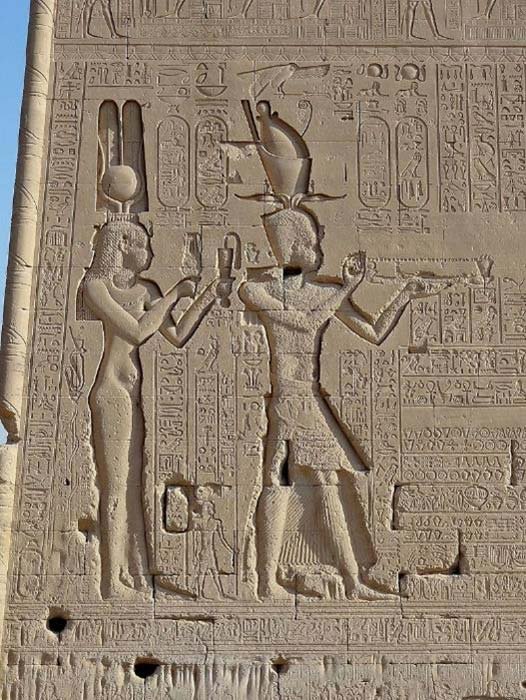
The relief of Queen Cleopatra VII and Caesarion, the Temple of Dendera
Hathor was also considered the Goddess of Healing, and this is evident from the presence of a wellness temple in the complex. Here, numerous pilgrims begged for health from the Goddess. The sacred water (as the ancient writings describe, the water was considered holy because it was poured out of the statue of the Goddess) was used for bathing, the priests of the temple of Hathor handed out prayer manuscripts to the sick, and the sleeping rooms were provided for those who hoped that the goddess would appear in a dream and will help cure. (Sanatorium, to her God!)

Complex in Dendera in the time of Christianity
When Christianity became the dominant religion in Egypt (at the dawn of a new era), a Christian basilica was built in the temple complex of Dendera. The archaeologists who investigated the remains of this structure assume that it was built in the 5th century AD. and is considered an excellent example of early Coptic church architecture. But unfortunately with time the complex was completely abandoned as a place of worship. When the scientists who accompanied Napoleon during his campaign in Egypt visited the site for the first time, they found only the ancient Bedouin village in the complex. The unique ceilings with paintings in the temple eventually turned black from the soot of the fading chandeliers, where local people prepared their own food.
Shadow of the Goddess Hathor
To this day, Hathor still remains one of the most popular goddesses of ancient Egypt. Next to Isis, Sekhmet and Bastet she acts as one of the symbols of ancient religion, the legendary ancient Egyptian beauty and femininity. The temple complex in Dendera has been restored and modern tourists can fully enjoy the splendor of its architecture and extraordinary design.
Many tourists who visit Egypt buy ornaments with turquoise - a female charm of the Goddess Hathor, as magical and mysterious as, indeed, the whole history of ancient Egypt.
Well, as usual - Welcome to Egypt!